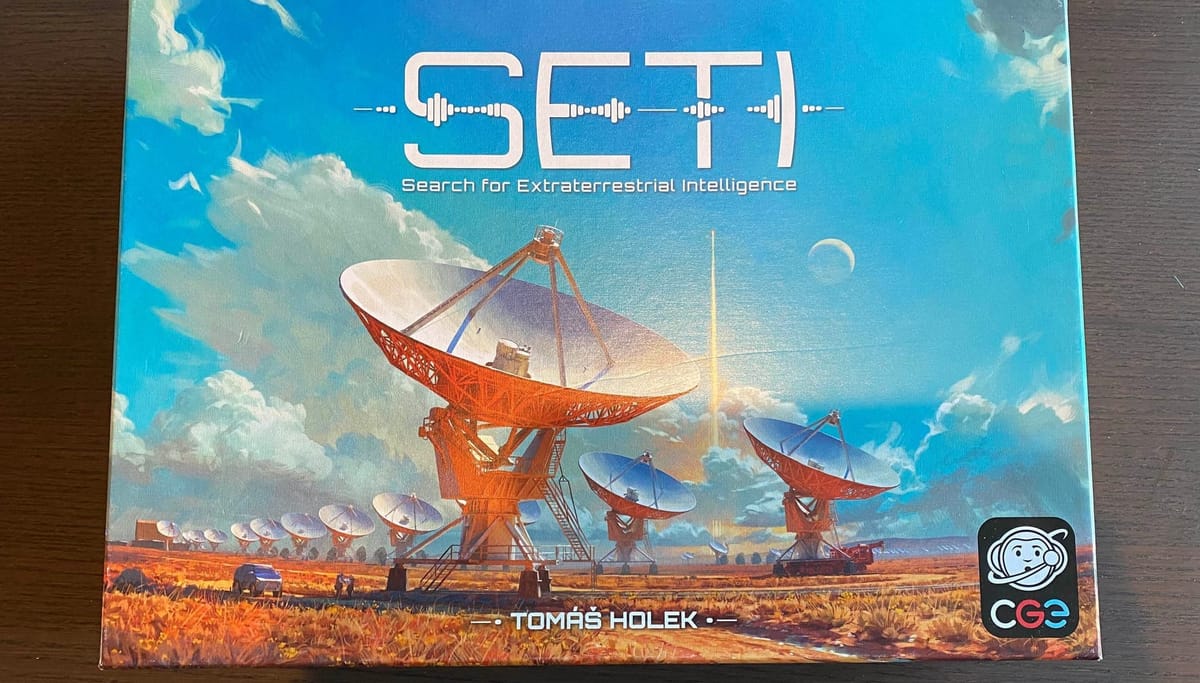
Have you ever looked up into the night sky and wondered if there was life out there? Maybe not within our solar system, but surely there must be something else in the infinite expanse of space, right? Shortly after the radio was invented, humanity began scanning and searching for signals from alien intelligence yet humanity still has not found evidence of extra-terrestrial intelligence (at least, nothing revealed to the public, if you want to put on your tinfoil hat). Fortunately, all those past failings mean nothing in CGE's latest game SETI, where players will find not one but two alien lifeforms, and—in typical eurogame fashion—compete to best exploit them for victory points.
Components and Rules
The board for SETI immediately caught my eye. Not only is it large with an abundance of color, but the solar system at its center is made of three movable rings with a plastic sun in the middle for those rings to rotate around. My initial concern was that actually rotating the rings would feel fiddly in some way, but luckily this was not the case—there are small nubs on the trailing end of each ring section to push, and the thick cardboard pieces never clipped each other, allowing for smooth rotation each time. My only complaint about the board itself is that the sector lines blend into the art in a few spots, especially around the sun, which can make it difficult for new players to tell spaces apart from across the table.
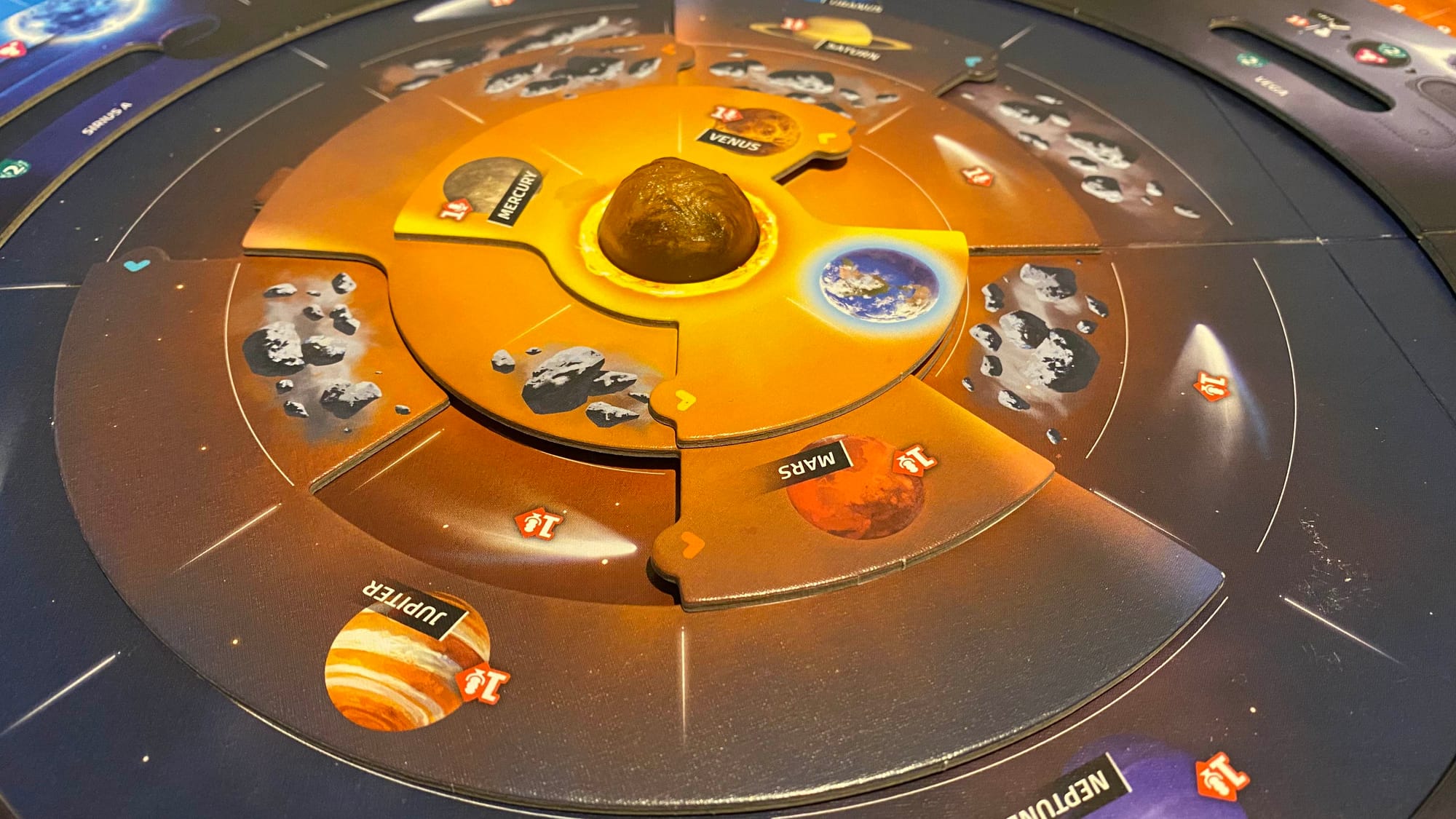
The player boards are also quite nice, with dual-layered slots for the tech tiles and the data pool. The other player components are nice and chunky plastic (except two cardboard tokens that don't get handled much) and the player colors themselves are distinct from both each other and any elements on the board.
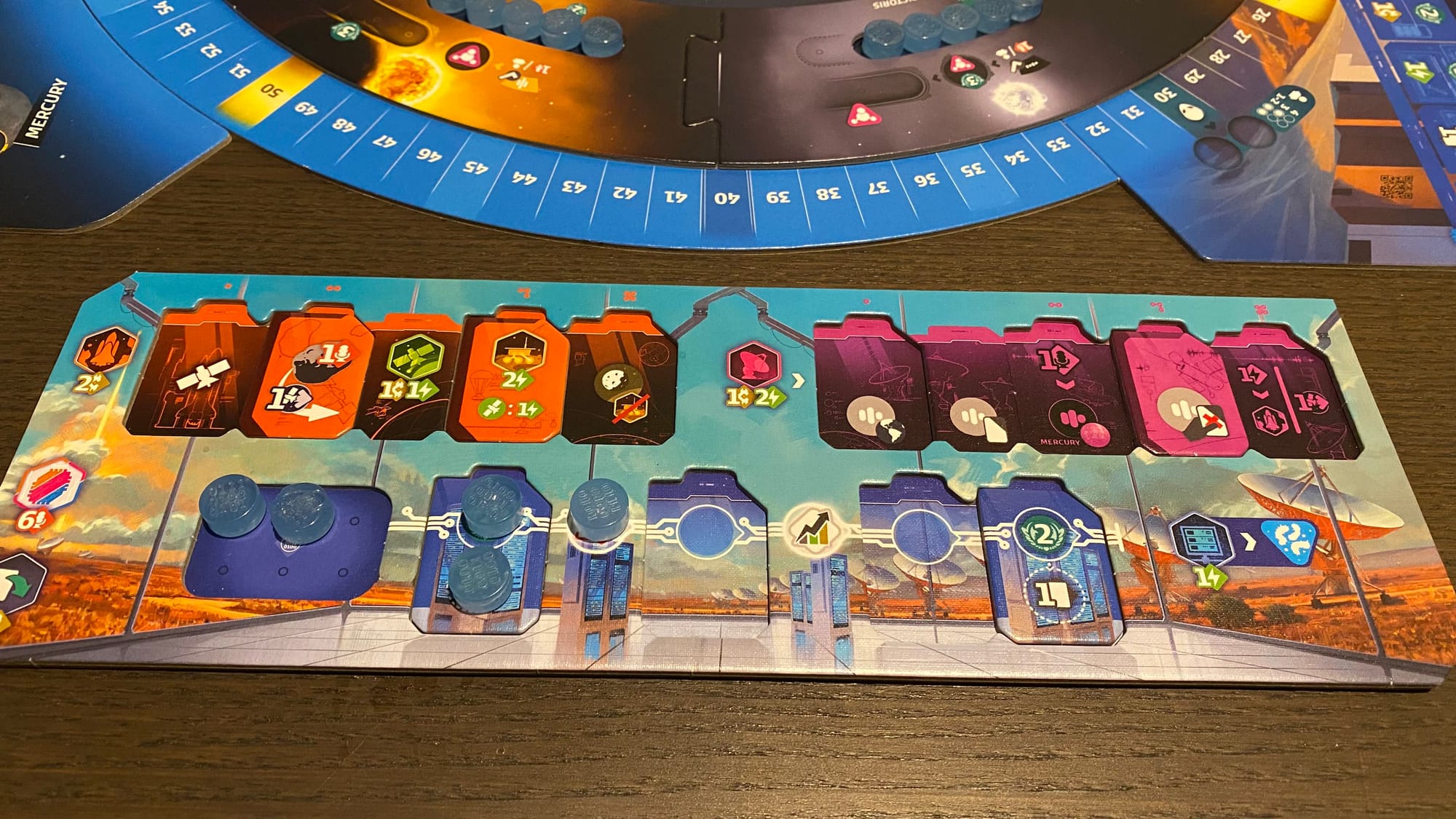
The rules are well-written and I never found myself doubling back or rereading any section in particular. Plenty of large images are used to help convey certain concepts, especially the double-page spread on launching and moving probes. There are also reference sheets for each player which list each action as well as both icon references and an explanation of each gold scoring tile. These reference sheets are a necessity for games with this much going on, and they certainly help new players get into the actual game.
Gameplay
I’ve played a lot of eurogames that have pretty dry themes or are barely connected to the theme at all. For many, the theme really is just slapped on after the design itself is finished. This is certainly not the case with SETI. Every action you take is dripping with a thematic connection more similar to Ameritrash games, from the mechanics of your probe movement to the flavor text connecting each card to some real-world project. While I don’t mind games with loose themes, strong ties like what SETI has help to both set it apart from similar titles and pull me into its world.
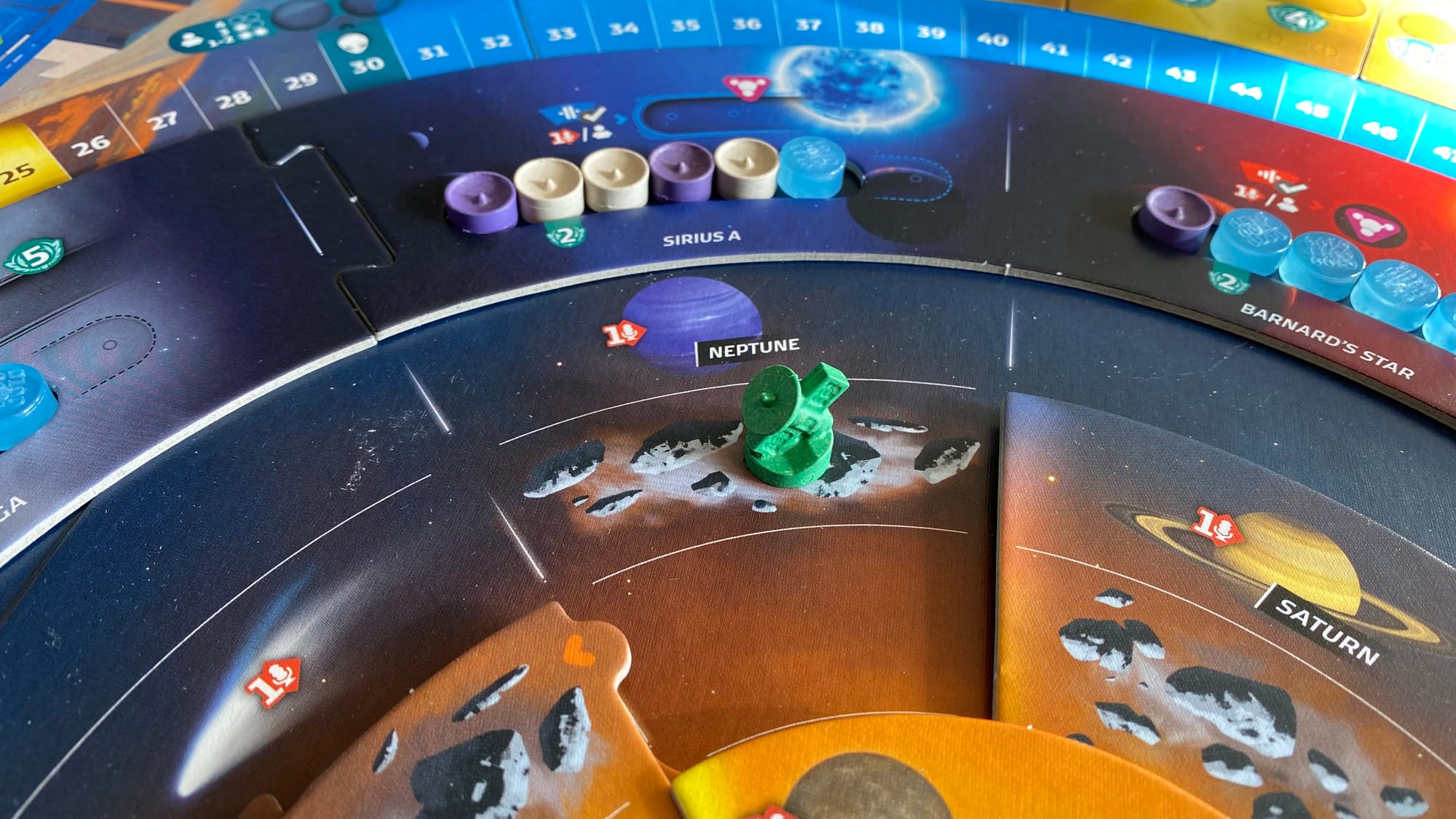
There's a lot to do in SETI—even before you actually find evidence of extra-terrestrial intelligence—and players are given the freedom to explore the different mechanics as they wish, for better or for worse. Players can launch probes and maneuver them to orbit or land on the various celestial bodies, scan distant stars to compete for control of a sector and collect data, plug data into their computers for bonuses and alien life traces, and research advanced tech to improve all the previous actions. Although these individual actions are relatively simple to perform, the bigger picture of what a player should be working towards can be hazy at times. Initially, the only guidance a player has are the cards in their hand which may have scoring goals or the public goals randomly drawn this game.
Luckily, these cards are incredibly versatile. In addition to playing the card as an action, with varying degrees of usefulness that I’ll get into later, each card can be discarded as a free action to gain one of three resources: publicity (for tech upgrades or buying more cards), movement (for your probes on the board), or data (for filling your computer and likely gaining more resources). These cards are also occasionally used to improve your end-of-round income or to scan specific sectors (provided you have the related tech tile). Spending any two cards can even grant you an energy or a credit. So, while the game may appear to focus on this widespread of connected actions, a larger part of it is managing all your resources and deciding which cards can be spent for minor benefits and which have actions worth paying for. Even the single point of probe movement some cards provide can be essential, as the solar system rotates each time a player purchases tech and the first time each round a player passes. Moving your probe during an ideal launch window may require sacrificing cards that you were hoping to play.
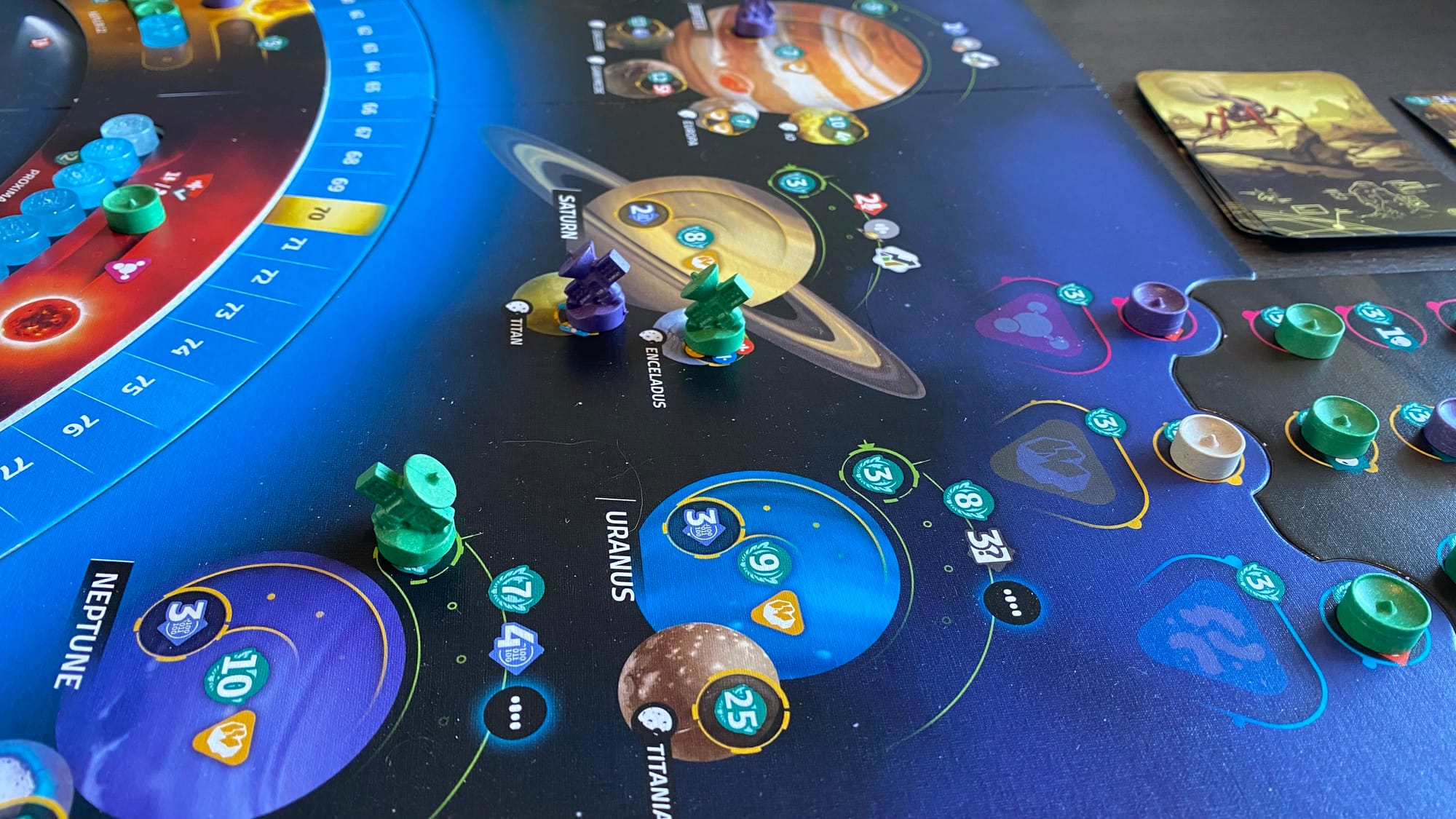
Unfortunately, some cards are significantly better than others, and there’s no control over what your starting hand contains. In one game, both my opponents started with cards that let them purchase tech on their first turns, while I had to wait and get my first tech with publicity around the same time they earned their second techs the same way. While I don’t mind drawing random cards during the game as much, the starting hand can dictate your initial strategy and I would have preferred some sort of simple draft or even starting with more and discarding several during setup. When a game is this long, it can feel disheartening when others seemingly luck into a strong lead.
Cards aside, the rest of the actions all feel very rewarding. Landing that probe on a distant moon for a pile of points or bonuses, conducting a well-timed scan that secures you tie-breaking control of a sector, or even getting a tech tile with an immediate bonus that lets you take just one more action this round. It all comes together when someone finally discovers the last life trace of an alien species, pausing the game at the end of their turn to flip over its board and go over the rules and benefits every player can now take advantage of.
The five different alien species you might encounter each integrates seamlessly into the game, adding more options and methods of interacting with the core mechanics without disrupting the experience players have had so far. One species adds a new pseudo-sector that players can compete to scan while another allows players to deliver capsules to Earth the same way they maneuver their probes. With the strong bonuses and scoring opportunities the aliens present, players are incentivized to interact with them as much as possible. Even though an alien may not be revealed until mid to late game, they never felt tacked on, and they always become a core part of the current game.
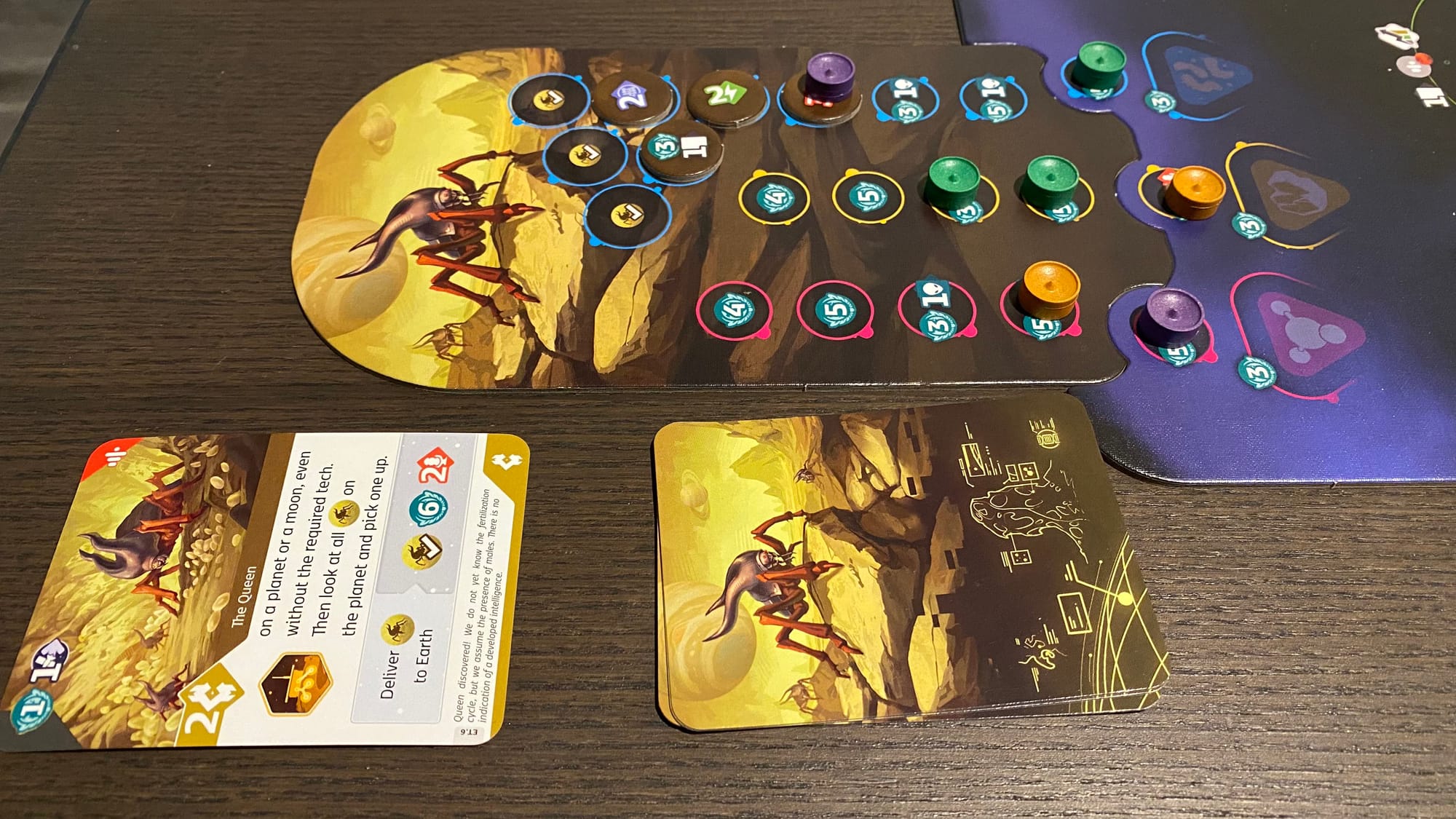
One of my most memorable experiences was a game where I was quite behind my opponents when the Exertians were discovered. Their gimmick is giving strong immediate bonuses and the possibility for significant end-game points, at the cost of a large chunk of points from the player that utilized them the most. I realized that neither of my opponents were interacting with them much and threw caution to the wind, interacting with their board every chance I got. Because I was able to use all their strong spaces, I more than made up for the points tax I suffered at the end of the game and managed to pull ahead.
With a game as long as SETI, which is easily four hours with new players, the “discovery” of aliens poses some problems. An alien species may not be revealed until round 3 or 4, which means that some players may need to quickly pivot to the new mechanics while others will luck into already playing their mechanic. For example, the Mascamites are all about launching probes to their planets and then delivering samples back to Earth. If a player is already set up to launch and move quickly and cheaply, then great! But if a player has been focusing primarily on scanning with only a smattering of probing, then they’ll have a harder time taking advantage of the new life. SETI expects its players to do a bit of everything until the late game, which puts the first few rounds in an odd spot strategy-wise.
Solo Mode
The AI is very simple to run, simply flipping over a card from its deck and running down a list of action priorities to find out what one thing they do. On my playthrough, they quickly established dominance in scanning but were slow to actually run their computer. But this wasn't an issue as the main feature wasn't their board presence but rather the goals they presented to the player.
Each AI difficulty, aside from levels 1 & 2 has a stack of goal tiles that the player must complete and turn in each round. Every goal that a player is unable to turn in gets the AI closer to improving their deck with more and better action cards. At the end of the game, every uncompleted goal scores the AI points. This mechanic does a fine job of giving the solo player some direction and competition instead of racing other players to the various items on the board. Though occasionally the goals are surprisingly difficult to achieve while still working on the objectives you set for yourself—my AI had mostly been scanning which made it hard to win certain sectors like one goal required.
Due to the game's size and weight, I would not say that the AI is robust enough to justify purchasing this from a purely solo-player perspective. The AI is fairly random, and aside from the goals you can't play around their actions, nor predict when they'll trigger a board rotation—which makes maneuvering your probes a bit trickier. However, if you're already a fan of multiplayer SETI then I believe it's worth giving the solo game a shot yourself.
SETI: Search for Extraterrestrial Intelligence
Great
SETI is a highly thematic eurogame with nicely interwoven mechanics that form a think-y puzzle for how best to use your limited resources. The game is only held back by some randomness that doesn't quite sit well with a game this long.
Pros
- Strong thematic connection
- Aliens integrate nicely into core gameplay
- Fun resource management puzzle
- Rulebook is easy to comprehend
Cons
- Some cards are much better than others
- Solo mode leaves a bit to be desired
- Alien reveals make early game planning uncomfortable
- Difficult to find a winning strategy
This review is based on a retail copy provided by publisher.
